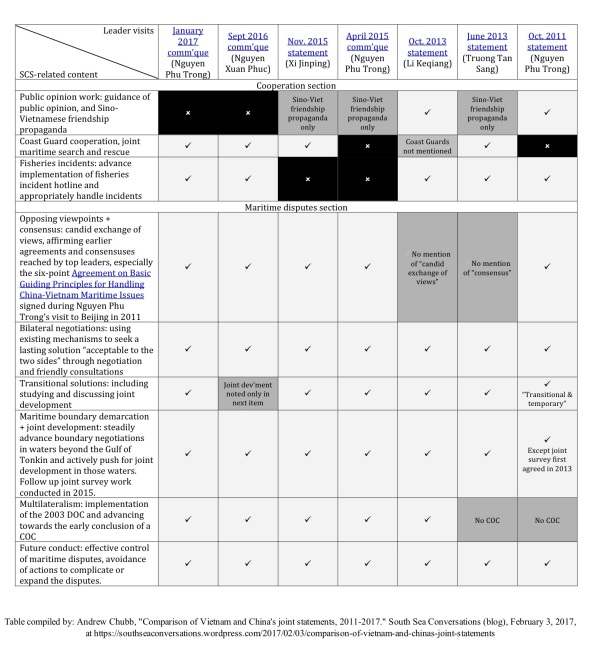Comparison of Vietnam and China’s joint statements, 2011-2017
Posted: February 3, 2017 Filed under: China-Vietnam, Ministry of Foreign Affairs, South China Sea | Tags: arbitration, China-Vietnam, China-Vietnam joint statement, China-Vietnam relations, joint communique, Nguyen Phu Trong, nine dashed line, nine-dash line, Philippines vs China arbitration, Sino-Vietnamese relations, south china sea, South China Sea arbitration, UNCLOS, UNCLOS and South China Sea, Vietnam-China joint statement 2 Comments
Comparison of Sino-Vietnamese joint statements since 2011 (click to enlarge). Links to sources: January 2017 communique (Nguyen Phu Trong visit to China); Sept 2016 communique (Nguyen Xuan Phuc visit to China); Nov. 2015 statement (Xi Jinping visit to Vietnam); April 2015 communique (Nguyen Phu Trong visit to China); Oct. 2013 statement (Li Keqiang visit to Vietnam); June 2013 statement (Truong Tan Sang visit to China); Oct. 2011 statement (Nguyen Phu Trong visit to China).
East Asia Forum has kindly published a piece from me on recent developments in Sino-Vietnamese relations. To supplement it, i’m posting here a table comparing the South China Sea-related elements of the last 7 joint statements between the two.
The comparative table was the basis for the article’s argument that General Secretary Nguyen Phu Trong’s visit to Beijing last month did not involve any softening of Vietnam’s position on the issue.
According to a knowledgeable Vietnamese source, there are three types of Sino-Vietnamese bilateral joint statements issued after high-level meetings. In ascending order of importance these are:
- Joint press release (联合新闻公报, thông cáo báo chí)
- Joint communique (联合公报, thông cáo chung)
- Joint statement (联合声明, tuyên bố chung)
These documents are often not released in English, and some of the translations that have appeared have been incomplete or unreliable, so the table above compares the Chinese full text as published by state media (links are in the caption area above).
The table also includes an item, not discussed in the EAF article for space reasons, on cooperation in public opinion work. In the 2011 joint statement, the two sides pledged cooperation on “strengthening public opinion guidance and management” – which, in the context of several weeks of anti-China protests through the middle of that year, was tantamount to a Vietnamese undertaking to dampen anti-China sentiments.
Interestingly, however, there has been no analogous item in the recent joint documents — even after another, even more intense, wave of anti-China sentiments burst forth in 2014 during the HYSY-981 oil rig standoff. Its omission from subsequent documents might indicate an acceptance on China’s behalf of the strength Vietnamese nationalist sentiments that flow in its direction at times of heightened tensions. Perhaps also an acknowledgement that Hanoi is already doing what it can to promote Sino-Vietnamese friendship? Any other readings?
The EAF piece is reposted below. Based on some early feedback, i should have been clearer that in suggesting . . .
China may have pulled back from its pursuit of particular claims that have no basis in international law
. . . i do not mean the PRC has seen the light and is abandoning all claims deemed unlawful in the UNCLOS arbitration. Just that there are some unlawful aspects of China’s claims that it is no longer pushing, and this has removed some of the major drivers of Sino-Vietnamese tensions.
As always, further comments, arguments, additions and corrections are much appreciated.

“The irony is exquisite”: Is Phoenix trying to ruin the Chinese Foreign Ministry’s credibility?
Posted: October 18, 2011 | Author: Andrew Chubb | Filed under: China-Philippines, China-Vietnam, Comment threads, Ministry of Foreign Affairs, PRC News Portals | Tags: Aquino, China-Vietnam, Chinese internet, Chinese media, Foreign Ministry, India-Vietnam, MFA, Ministry of Truth, Nguyen Phu Trong, Phoenix News, SARFT, Truong Tan Sang | 1 CommentToday China’s major websites appear to have been instructed to prominently publicize Foreign Ministry spokesman Liu Weimin’s comment [EN] about the recent Sino-Vietnamese agreement on the South China Sea dispute having nothing to do with any other country.
Liu was responding, mundanely, to Philippines President Aquino’s equally mundane reiteration that only multilateral negotiations can solve the dispute.
But Sina, Sohu, Netease, Phoenix and QQ all have the story on the front page of their news sites, the latter three particularly prominently. Beneath the main headline “Foreign Ministry: China and Vietnam solving their maritime disputes has nothing to do with any third country” there appear links to reports about the announcement of the joint declaration and Aquino’s protest, and this is the case on both Netease, Phoenix and QQ, a good indication that some kind of edict is governing the story’s treatment.
While evidently toeing the line and following instructions, however, Phoenix seems to have slipped a sneaky little spanner into the propaganda machine as it works to sell the government’s latest diplomatic achievement. Below the headline, Phoenix has helpfully added a third subsidiary link, to a story from 6 days ago titled, “India, Vietnam sign agreement, will exploit oil in disputed areas of the SCS”.
This story was a translated summary of AP’s report outlining Vietnamese President Truong Tan Sang’s trip to New Delhi to oversee the signing of a new accord between Indian and Vietnamese state-owned oil companies’ to promote oil exploration in Vietnamese-claimed waters. President Truong’s trip took place precisely as Vietnamese Communist Party General Secretary Nguyen Phu Trong was over in Beijing, signing the above-mentioned joint declaration with China – a very inconvenient dampener on the Chinese Foreign Ministry’s happy tale of Sino-Vietnamese agreement.
With the stories placed alongside one another, the obvious conclusion was not lost on readers, as the top comments from the 41,000-strong Phoenix discussion indicate: